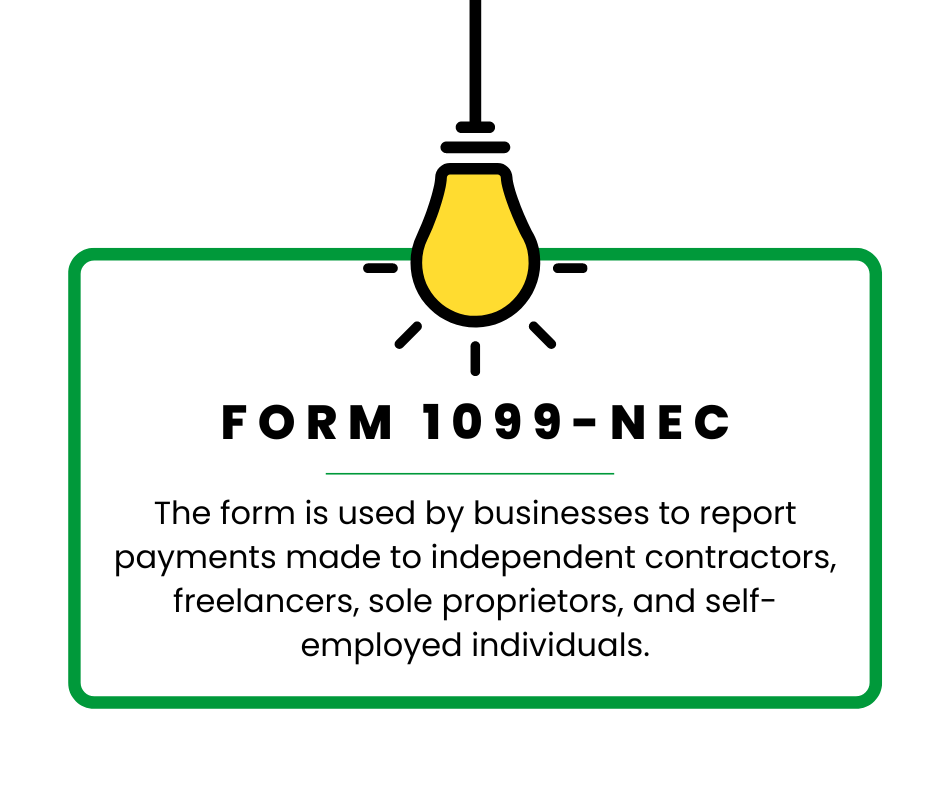The world of taxes can be complex and overwhelming, especially for freelancers and independent contractors. One crucial form that individuals in these categories need to understand is the 1099 NEC. In this article, we will explore the definition, purpose, recipients, contents, reporting requirements, and additional considerations surrounding the 1099 NEC form.
This article has been prepared for informational purposes only and gives a general overview of Form 1099-NEC. It is not intended to provide any tax advice. Keep in mind that it’s better to consult with a tax professional to ensure that the form is properly filled.
Definition and purpose of a 1099 NEC

The 1099 NEC, or Form 1099-NEC, is a tax form businesses and individuals use to report payments made to non-employees for services rendered. NEC stands for Nonemployee Compensation, which refers to income earned by independent contractors, freelancers, and self-employed individuals.
Prior to 2020, nonemployee compensation was reported on Form 1099-MISC. However, the Internal Revenue Service (IRS) reintroduced the 1099 NEC to separate the 1099-MISC Form nonemployee compensation reporting from other miscellaneous income. This change was made to improve clarity and accuracy in tax reporting, ensuring that nonemployee income is accurately reported and distinguished from other types of income.
The primary purpose of the 1099 NEC is to provide information to the IRS about payments made to non-employees, allowing the IRS to track and verify income reported by these individuals. By receiving a 1099 NEC, the recipient is notified that their income has been reported to the IRS, and they are responsible for including that income on their tax return.
Businesses and individuals who make payments of $600 or more to non-employees for services rendered during the tax year are required to issue a 1099 NEC to the recipient and submit a copy to the IRS. The form helps the IRS ensure compliance with tax laws and prevent underreporting of income.
The 1099 NEC also serves as a record-keeping tool for both the payer and the recipient. It provides documentation of the income received by the recipient, which they can use to report their earnings and fulfill their tax obligations accurately. Payers can refer to the 1099 NEC when preparing their own tax returns and maintaining records for auditing purposes.
Who receives Form 1099-NEC?
The 1099 NEC is issued by individuals or entities that have paid at least $600 to a non-employee for services rendered during the tax year. Common scenarios where a 1099 NEC may be issued include payments made to freelancers, consultants, independent contractors, and self-employed individuals. If you receive a 1099 NEC, it means the payer has reported your earnings to the IRS.
Determining if you should receive a 1099 NEC depends on various factors, including the nature of the work you performed, your relationship with the payer, and the amount of income earned. However, it’s important to note that even if you don’t receive a 1099 NEC, you are still responsible for reporting your income to the IRS.
What payments need to be reported on the Form 1099-NEC?
It is important to accurately report the income from Form 1099-NEC and properly calculate your self-employment taxes to ensure that you are meeting your tax obligations. It is recommended to consult a tax expert or use tax software to help you accurately report your income, determine your tax liability, and maximize any eligible deductions or credits.
The Form 1099-NEC is used to report nonemployee compensation, specifically payments made to independent contractors, freelancers, and self-employed individuals for services rendered. It is important to understand what types of payments fall under the category of nonemployee compensation and should be reported on Form 1099-NEC. Here are some common examples:
- If you hired an independent contractor to perform services for your business or personal use and paid them $600 or more during the tax year, you are required to report those payments on a Form 1099-NEC. This can include a wide range of services such as graphic design, consulting, web development, writing, maintenance, or any other professional services.
- If you hired freelancers to complete projects or assignments for your business and compensated them $600 or more in the tax year, those payments should be reported on Form 1099-NEC. This includes individuals who provide creative work, marketing services, event planning, and more.
- If you pay commissions to non-employees, such as independent sales agents or referral partners, and the total amount paid to an individual is $600 or more in the tax year, those commission payments should be reported on Form 1099-NEC.
- If you engage contract labor for specific tasks or projects, and the total compensation paid to an individual contractor reaches $600 or more during the tax year, those payments should be reported on Form 1099-NEC.
It’s important to note that Form 1099-NEC is specifically for reporting nonemployee compensation. Other types of payments, such as rent, royalties, or awards, may be reported on different forms depending on the nature of the payment.
When preparing Form 1099-NEC, it is crucial to collect accurate and complete information from the recipients, including their name, address, and Taxpayer Identification Number (TIN) or Social Security Number (SSN). This ensures the correct reporting of payments to the IRS and allows recipients to report their income properly.
1099-NEC and tax return
Form 1099-NEC itself does not directly impact your tax refund. However, the income reported on Form 1099-NEC can affect your overall tax liability, which can then influence the amount of your tax refund or the amount you owe.
When you receive income reported on Form 1099-NEC, it is important to understand that taxes are typically not withheld from these payments. This means that you may have an additional tax liability when you file your tax return. The income reported on Form 1099-NEC is generally subject to self-employment taxes, including Social Security and Medicare taxes.
To calculate your overall tax liability, you will need to consider all of your income sources, including any wages reported on a W-2 form, as well as the income reported on Form 1099-NEC. You will also be able to claim deductions and credits to help reduce your taxable income and potentially lower your tax liability.
The tax refund or the amount you owe is determined by comparing your total tax liability with the amount of taxes you have already paid throughout the year, including any tax withheld from your wages reported on a W-2 form, estimated tax payments, or any other tax credits you may be eligible for.
If the total amount of taxes you have already paid exceeds your tax liability, you may be eligible to file a tax return form. On the other hand, if your tax liability is higher than the taxes you have already paid, you may owe additional taxes when you file your tax return.
IRS deadlines for the 1099 NEC forms
The deadline for filing Form 1099-NEC varies depending on whether you are filing electronically or by paper. Here are the general deadlines for filing Form 1099-NEC:
- If you choose to file Form 1099-NEC electronically, the deadline for submission to the IRS is typically March 31st of the year following the tax year in which the payments were made. This deadline applies regardless of whether you are filing just a few forms or a larger batch.
- If you prefer to file Form 1099-NEC by paper, the deadline for submission to the IRS is typically February 28th of the year following the tax year in which the payments were made. However, if February 28th falls on a weekend or federal holiday, the deadline is extended to the next business day.
It’s important to note that these deadlines refer to the date the forms must be filed with the IRS. Additionally, if you are filing Form 1099-NEC, you are also required to provide a copy of the form to the recipient. The deadline for providing the recipient with a copy of Form 1099-NEC is generally January 31st of the year following the tax year.
Please note that it’s always best to consult the current IRS guidelines or seek advice from a tax professional for the most up-to-date and accurate information regarding filing deadlines for Form 1099-NEC.
Impact of 1099-NEC on taxes and taxpayers
The 1099 NEC plays a crucial role in income tax reporting for freelancers and self-employed individuals. Since taxes are not withheld from non-employee compensation, recipients of the 1099 NEC are responsible for calculating and paying their own taxes. This includes self-employment taxes, which cover Social Security and Medicare contributions.
While self-employment taxes can be substantial, it’s important to note that the 1099 NEC also offers potential deductions and credits for freelancers and independent contractors. Expenses related to your business can often be deducted, reducing your taxable income. Consulting with a tax professional can help you identify eligible deductions and ensure you maximize your tax benefits.
What if a business fails to meet the 1099 NEC deadline?
If a business fails to meet the deadline for filing Form 1099-NEC, there may be penalties and consequences imposed by the Internal Revenue Service (IRS). It’s important for businesses to adhere to the reporting requirements to avoid potential penalties and ensure compliance with tax regulations. Here’s what you need to know:
Late filing penalties
If a business fails to file Form 1099-NEC by the designated deadline, the IRS may impose penalties. The amount of the penalty depends on how late the filing is and the size of the business. As of the current guidelines, the penalties for late filing range from $50 to $550 per form, depending on the length of the delay. The penalties can increase significantly if there is intentional disregard for the filing requirements.
Incomplete or incorrect forms
Filing incomplete or incorrect forms can also result in penalties. It’s important to ensure that the information provided on Form 1099-NEC is accurate and complete. This includes the payer’s and recipient’s information, payment details, and any tax withheld. In case of errors or omissions, it is advisable to promptly correct and resubmit the form to avoid penalties and ensure accurate reporting.
Reasonable cause and correction
In certain situations, the IRS may waive penalties for late filing if the business can demonstrate reasonable cause for the delay. This requires providing a valid and acceptable explanation for the late filing. However, it’s important to note that the IRS evaluates reasonable cause requests on a case-by-case basis, and not all requests may be granted. It’s best to consult with a tax professional for guidance on how to navigate the process of requesting a penalty waiver based on reasonable cause.
To mitigate the risk of late filing penalties, businesses should establish proper systems and processes to ensure timely and accurate reporting of Form 1099-NEC. This includes maintaining thorough records of non-employee payments, setting reminders for filing deadlines, and implementing appropriate internal controls to meet reporting requirements.
Learn about the IRS audit red flags, Ecommerce business insurance and How to calculate cash flow.
Understanding the Form 1099-NEC: Conclusion
Understanding the 1099 NEC is essential for freelancers and independent contractors. This tax form serves as a means to report nonemployee compensation, ensuring compliance with IRS regulations. By grasping its definition, purpose, recipients, contents, reporting requirements, and tax implications, taxpayers can navigate the tax landscape with confidence.
For personalized advice, it is advisable to seek the guidance of a qualified tax professional to ensure accurate reporting and maximize tax benefits.

.png)




